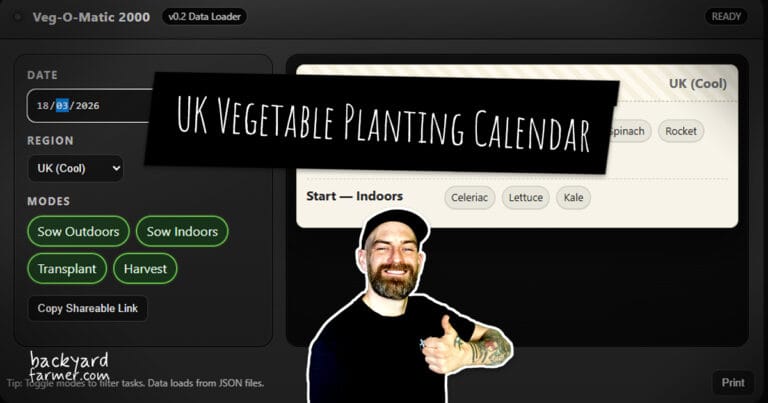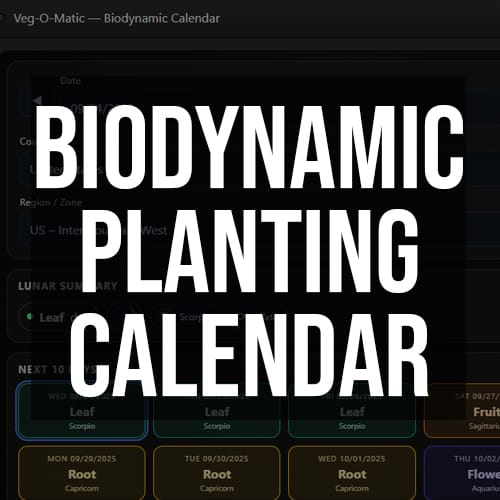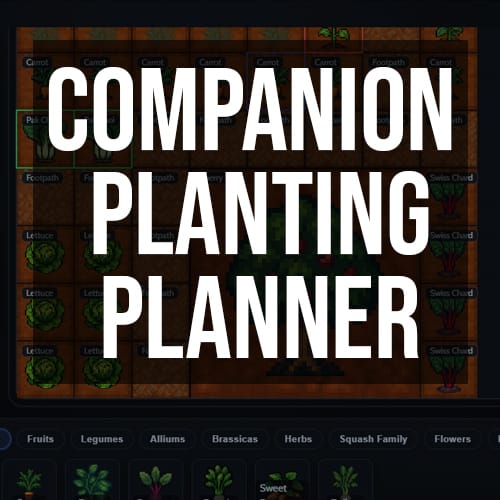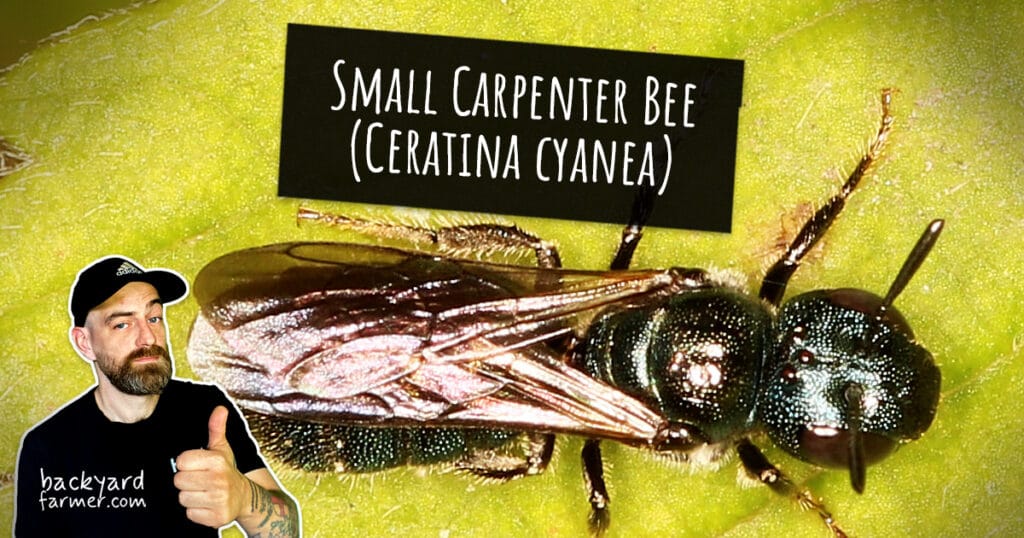Table of contents
- Introduction: Why a UK Planting Calendar Matters
- Try the Interactive UK Planting Calendar
- How the UK Planting Calendar Works
- Why Use a UK Planting Calendar?
- Understanding UK Climate Zones and Frost Dates
- Seasonal Planting Calendar: What to Grow When
- Crop Families & Rotations
- UK Planting Calendar: Month-by-Month Guide
- Tools and Resources for Planning Your UK Garden
- Frequently Asked Questions (FAQs)
- Next Steps and Additional Resources
*please note that there isnt much planting to do in the UK Planting Calendar until Feburary 2026, time to put your feet up and have brew! For more on what you can do in winter read our article ‘What Can I Grow in the Autumn and Winter Months‘.
Introduction: Why a UK Planting Calendar Matters
Knowing what to plant and when is half the battle in gardening. In the UK, our seasons can be unpredictable, and missing a key sowing window often means waiting another year. A reliable UK planting calendar helps you stay on track—whether you’re growing veg for the first time or fine-tuning a seasoned plot.
Try the Interactive UK Planting Calendar
We’ve built a free, easy-to-use vegetable planting calendar tool designed for UK growers. Just pick your region, choose between vegetables or culinary herbs, and select your growing method (indoors, outdoors, or transplant). Instantly, you’ll see what you can plant today—along with upcoming sowing and harvest dates.
Think of it as your personalised planting guide: always up to date, always relevant to your location, and far easier to follow than a static chart. Whether you’re planning a few pots on a balcony or a full vegetable patch, the tool gives you a clear picture of what to start right now.
No more tedious scrolling to find what and when to plant vegetables, like when you use the old RHS Vegetable Planting Calendar. The Backyard Farmer Vegetable Planting Calendar loads up on the current day and tells you what to do with your veg patch!
With the tool ready at your fingertips, the rest of this article dives into seasonal tips, herbs vs. vegetables, and extra resources to help you build the most productive garden possible.
Once you know what to plant, find out how best to plant them with our Free ‘Allotment & Companion Planting Planner here’.
More FREE Interactive Gardening Tools
How the UK Planting Calendar Works
A UK planting calendar isn’t just a list of dates — it’s your seasonal roadmap for successful growing. It aligns what you sow, plant, and harvest with Britain’s shifting climate. This helps you avoid failed germination, protect tender seedlings, and make the most of every growing window.
Key Factors That Shape the Calendar
- Frost Dates — The last frost in spring and the first frost in autumn are the bookends for outdoor sowing. These vary by location: earlier and milder in the south, later and harsher in the north or upland areas.
- Regional Climate Zones — To keep things simple, this gardening calendar for the UK divides the country into three broad zones: average, mild, and cool. Adjust timings by a week or two depending on your own conditions.
- Crop Type — Each vegetable or herb has its own temperature sweet spot. Hardy crops like carrots, parsnips, and broad beans cope with cooler soil. Heat-lovers like basil, chillies, and tomatoes need warmth to thrive.
Categories of Planting Windows
The UK vegetable planting calendar makes jobs clear by grouping them into four categories:
- Sow Indoors — Start seeds in trays, modules, or pots under cover, whether in a greenhouse, polytunnel, or on a sunny windowsill.
- Sow Outdoors — Direct sow into beds, containers, or allotments once soil and weather conditions are right.
- Transplanting — Move young plants raised indoors outside once the soil has warmed and frost risk has passed.
- Harvesting — Pick crops at their peak for flavour, nutrition, and storage.
Why Timing Matters
Sow too early and seeds may rot or seedlings get hit by frost. Plant too late and crops won’t mature before the season closes. By using this UK gardening calendar, you can:
- Maximise the growing season and get more from your garden.
- Spread gardening jobs across the year instead of cramming them into a short window.
- Ensure a steady supply of fresh food from spring through autumn.
The Bottom Line
A planting calendar for the UK balances climate, crop type, and timing. That’s what makes it such a practical and reliable guide for gardeners across Britain.
Why Use a UK Planting Calendar?
A UK planting calendar isn’t just a schedule — it’s your shortcut to getting the most from your garden. By knowing when to sow, transplant, and harvest, you’ll save money on seed, cut down on wasted effort, and enjoy stronger, healthier crops. A reliable gardening calendar for the UK takes the guesswork out of timing and helps you grow with confidence.
1. Timing Is Everything
Plants respond to light, temperature, and soil conditions. Sow too early and seedlings risk frost damage. Sow too late and you might miss the growing window altogether. A vegetable planting calendar for the UK ensures you catch the right moment for each crop so your seeds have the best chance to thrive.
2. Maximise Yields
When crops are planted in sync with the season, they grow stronger, face fewer setbacks, and produce more. Using a UK gardening calendar keeps your plants in their natural rhythm, leading to bigger harvests with less hassle.
3. Extend Your Growing Season
With a bit of planning, you can enjoy fresh produce for months longer. The calendar shows when to start seeds indoors, when to move them outside, and which vegetables can give you second or even third harvests later in the year. Succession sowing becomes much easier with a clear guide.
4. Reduce Waste and Save Money
Seeds, compost, and space are too valuable to waste. Planting at the right time means fewer failures and more food on the table. A clear planting guide for UK gardens minimises trial and error, making every square foot of your growing space count.
5. Grow with Confidence
For new gardeners especially, a UK planting schedule removes the uncertainty. Instead of second-guessing what’s next, you’ll know exactly what to plant and when. That way, your garden stays productive and rewarding all year round.
👉 For a deeper look at lunar phases, zodiac signs, and the best planting days, explore our Biodynamic Planting Calendar 2025 – Free Interactive App (UK & US).
Understanding UK Climate Zones and Frost Dates
A big challenge for UK gardeners is dealing with varied climates. The country may be small, but its regions have very different weather patterns and frost dates. These differences shape your UK planting calendar and directly affect what you can grow — and when.
Climate Variations Across the UK
When planning your vegetable planting calendar for the UK, it helps to think of the country in three broad gardening zones:
- Mild regions (Cornwall, South West, coastal areas): Longer growing seasons, milder winters, and earlier last frost dates make these areas ideal for early sowings.
- Average regions (Midlands, South East, much of lowland England): Moderate conditions with frost dates that most UK planting guides are based on.
- Cool regions (Scotland, northern England, upland areas): Shorter growing seasons, later spring frosts, and earlier autumn frosts limit choices but still allow many hardy crops.
Frost Dates and Why They Matter
Frost dates are central to every gardening calendar and planting schedule in the UK:
- Last frost date: The average spring date when tender crops can be safely planted outdoors.
- First frost date: The average autumn date when frost returns, marking the end of the season.
Why this matters:
- Start seeds indoors and transplant after the frost risk passes.
- Save time, seed, and compost by avoiding sowing into cold, unworkable soil.
- Plan succession sowings so harvests last until the first frosts.
Regional and Local Adjustments
Even within regions, microclimates play a role. For example, a sheltered urban garden may stay warmer and extend the season compared to an exposed rural plot. That’s where tools like the What to Plant Today app or a tailored UK vegetable planting guide become invaluable. They help you fine-tune your planting calendar to local conditions rather than relying only on a generic schedule.
Key takeaway: Understanding your climate zone and local frost dates lets you build a planting calendar that matches your conditions. This gives you more confidence, smoother transplanting, and longer harvests throughout the season.
Seasonal Planting Calendar: What to Grow When
If you’re growing vegetables and herbs in the UK, timing is everything. The changing seasons, variable daylight, and unpredictable frosts all shape what you can plant and when. A clear vegetable planting calendar UK guide helps you plan sowing, transplanting, and harvesting so you get the best from your garden all year round.
Spring (March–May)
The season of new starts. As the soil warms and daylight stretches, spring becomes the busiest time in any planting guide.
What to Sow and Plant in Spring
- Sow outdoors: carrots, beetroot, spinach, peas, broad beans, lettuce, and onions.
- Sow indoors/under cover: tomatoes, chillies, cucumbers, courgettes, and basil.
- Transplant: hardy brassicas such as cabbages, kale, and broccoli started earlier indoors.
Key takeaway: Use fleece or cloches to protect tender seedlings from late frosts.
Summer (June–August)
The season of abundance. Growth speeds up, and harvests roll in thick and fast—an essential stage in any UK vegetable sowing calendar.
What to Sow and Harvest in Summer
- Sow outdoors: succession crops of lettuce, radishes, spring onions, and dwarf beans.
- Sow indoors: a final round of courgettes or cucumbers for late harvests.
- Harvest: early potatoes, garlic, strawberries, peas, and broad beans.
Key takeaway: Water consistently and mulch well to prevent plants from drying out.
Autumn (September–November)
A season of transition. Cooler weather slows growth, but plenty of planting and harvesting remain before winter sets in.
What to Sow and Harvest in Autumn
- Sow outdoors: spinach, winter lettuces, pak choi, and field beans.
- Plant out: garlic, onion sets, and overwintering broad beans.
- Harvest: squash, pumpkins, maincrop potatoes, apples, and brassicas.
Key takeaway: Cover bare soil with compost or green manure to keep it fertile for spring.
Winter (December–February)
A time for rest and resilience. Growth slows almost to a stop, but hardy crops still keep your garden productive.
What to Harvest and Prepare in Winter
- Harvest: kale, leeks, parsnips, Brussels sprouts, and winter cabbages.
- Prepare: plan crop rotations, dig in compost, and repair garden structures.
- Sow indoors (late winter): chillies, aubergines, and early tomatoes for a head start.
Key takeaway: Use winter to plan, maintain, and enjoy hardy harvests while setting yourself up for spring.
Final takeaway: By following a seasonal planting calendar UK, gardeners can keep fresh food on the table all year. Combine this with tools like the What to Plant Today app, and you’ll receive tailored advice that matches your region and microclimate.
Did this tool save you time or money?
This free Digital Tool is built and maintained for the community. Buying me a coffee helps keep it free, fast, and regularly updated.
Crop Families & Rotations
Keeping your garden soil healthy and productive starts with crop rotation. This traditional method, highlighted in many UK vegetable growing guides, balances nutrients, reduces pests, and lowers the risk of soil-borne diseases. In simple terms, crop rotation means moving plant families around your veg patch each year, creating a natural cycle that strengthens long-term soil fertility.
Why Rotate Crops?
- Disease prevention: Soil-borne issues like clubroot in brassicas or blight in potatoes can linger for years. Following a clear crop rotation plan helps break these cycles.
- Balanced nutrition: Different plant families draw nutrients differently. Legumes add nitrogen, while root crops rely on potassium. Rotating ensures your soil stays balanced.
- Pest control: Switching crops makes it harder for pests to find their favourite plants year after year, protecting your harvest naturally.
The Four-Year Rotation System
A tried-and-tested vegetable rotation system for UK gardens divides your plot into four main groups:
1. Brassicas (cabbage, broccoli, kale, sprouts, cauliflower)
- Thrive on nitrogen fixed by legumes.
- Heavy feeders that need compost-rich soil.
2. Legumes (peas, beans, broad beans)
- Improve the soil by fixing nitrogen.
- Best followed by hungry brassicas.
3. Root Crops & Alliums (carrots, parsnips, beetroot, onions, garlic, leeks)
- Prefer lighter, less rich soil to avoid distorted roots.
- Fit well after nutrient-demanding crops.
4. Potatoes & Fruiting Crops (potatoes, tomatoes, courgettes, pumpkins)
- Dense foliage helps suppress weeds.
- Benefit from plenty of compost and organic matter.
Herbs in Rotation
- Perennial herbs like rosemary, thyme, mint, and sage don’t need rotation—they’ll thrive in the same spot for years.
- Annual herbs such as basil, coriander, and dill can slot into a vegetable rotation plan. Place them with crops that share their soil and water needs.
Tips for Success
- Keep a simple log of your crop rotation schedule so you know what’s been planted where.
- Add compost or organic matter at the start of each cycle to refresh the soil.
- If space is tight, even a two-year swap (roots one year, brassicas the next) helps maintain soil health.
Takeaway: Crop rotation may be traditional, but it’s still one of the most effective ways to build fertile, resilient soil and support a healthy, year-round harvest in your garden.
UK Planting Calendar: Month-by-Month Guide
The UK’s mild climate means you can grow plenty of vegetables and herbs almost year-round — but timing is everything. Following a UK planting calendar helps you know exactly when to sow seeds, plant out young crops, and harvest. A clear month-by-month gardening guide takes the guesswork out, helping you grow more food and make the most of your plot.
January–February
- Focus: Get organised, prepare garden beds, and start early seeds indoors.
- Examples: Sow onions, leeks, and early brassicas in trays under cover. Chit potatoes in a cool, bright spot to prepare for spring planting.
March–April
- Focus: Main sowing season as the soil begins to warm.
- Examples: Direct sow carrots, beetroot, lettuce, and peas outdoors. Start tender crops like tomatoes, peppers, and courgettes indoors or in a greenhouse.
- Tip: Use cloches or fleece to protect early sowings in cooler parts of the UK.
May–June
- Focus: Move tender crops outside after the last frost.
- Examples: Plant out tomatoes, cucumbers, sweetcorn, and climbing beans. Continue sowing quick crops such as salads and root veg every couple of weeks.
- Key SEO note: This is peak time in the vegetable planting calendar UK, so consistency and succession planting are vital.
July–August
- Focus: Harvest summer crops while sowing for autumn.
- Examples: Sow kale, spinach, and turnips for cooler months. Harvest beans, courgettes, and salad leaves frequently to extend yields.
- Tip: Check your UK vegetable growing guide for heat-tolerant lettuce if summers run hot.
September–October
- Focus: Gather main harvests and prepare for winter.
- Examples: Lift potatoes, onions, and squash for storage. Sow overwintering broad beans, garlic, and spring onions to get a head start for next year.
- Key SEO note: This stage of the gardening calendar UK sets up successful winter cropping.
November–December
- Focus: Protect crops and plan ahead.
- Examples: Mulch beds, net brassicas against pigeons, and draw up next year’s crop rotation. Harvest hardy greens like kale and winter lettuce.
- Tip: Winter sowings of broad beans and garlic keep your plot productive even in the colder months.
Bottom line: The UK planting calendar isn’t one-size-fits-all. It changes depending on whether your garden is in a mild coastal area, an average central spot, or a cooler northern region. Tools like the Veg-O-Matic 2000 help you fine-tune sowing dates around local frost patterns, keeping your harvests on track all year.
Tools and Resources for Planning Your UK Garden
The right tools for planning your UK garden save time and keep your vegetable patch or herb bed thriving. Whether you lean towards digital planners or prefer traditional methods, using a system helps you stay organised and aligned with the UK gardening calendar.
Digital Garden Planners
Many growers now rely on digital tools to manage planting schedules. Our interactive UK planting calendar app gives instant guidance on what to sow, transplant, and harvest based on your region and season. It’s mobile-friendly, printable, and easy to bookmark for quick reference.
Other helpful apps include:
- Gardenate – a straightforward planting calendar app that highlights what to sow each month in the UK.
- RHS Grow Your Own – filled with reliable crop guides from the Royal Horticultural Society.
Traditional Methods
If you prefer a more hands-on approach, a garden diary or wall calendar works brilliantly. Record sowing, transplanting, and harvesting dates. Over time, these notes build a personalised vegetable planting calendar, giving you valuable insights when planning the next year’s garden.
Reference Books and Charts
Trusted resources for UK gardeners include:
- The Vegetable & Herb Expert by Dr D.G. Hessayon – a classic guide for both beginners and experienced growers.
- Charles Dowding’s No Dig Gardening Course Book – a practical guide to organic, low-maintenance growing.
- RHS planting and growing charts – providing region-specific advice on when to plant and harvest.
Online Communities and Forums
Digital communities are just as valuable as books. UK-based forums and Facebook groups offer direct access to local knowledge. Sites such as Grow Your Own (GYO) Forum and Allotment Gardening UK are packed with seasonal advice, sowing tips, and real-life experiences.
Key takeaway: The best garden planning tool is the one you’ll use consistently. Whether it’s our digital UK planting calendar, a simple diary, or trusted RHS guides, a clear system will keep your garden productive all year long.
Frequently Asked Questions (FAQs)
Even with the best UK gardening tools and resources, many growers still run into the same questions each season. Below are clear, practical answers to help you plan with confidence and make the most of a UK vegetable planting calendar.
When should I start seeds indoors vs. outdoors?
Timing depends on the crop and your region:
- Start indoors: Tender plants like tomatoes, peppers, and basil do best when started indoors from late winter to early spring. They’ll be stronger and ready for transplanting after the last frost.
- Sow outdoors: Hardy crops such as carrots, parsnips, and peas can be sown directly outside once the soil is workable—usually from March in much of the UK.
Key takeaway: Start tender crops indoors for protection, but direct sow hardy crops outdoors when conditions allow.
How do I know my region’s frost dates?
Frost dates vary across the UK:
- Mild regions (southern or coastal areas): Last frost is usually early April, with the first frost around early November.
- Cooler regions (northern areas or higher ground): Last frost can be as late as May, with the first frost in October.
Always check a local gardening calendar or reliable forecast, since microclimates can shift dates by a week or two.
Key takeaway: Frost dates differ by location, so use local guides for the most accurate results.
Which vegetables are the easiest for beginners?
If you’re just starting out, choose quick and reliable crops:
- Lettuce and salad leaves
- Radishes
- Courgettes
- Beans and peas
- Potatoes
These staples grow with little fuss and deliver quick rewards—ideal for a beginner’s UK vegetable garden.
Key takeaway: Choose simple crops like lettuce, beans, and potatoes for reliable first harvests.
Do I need a greenhouse to grow herbs?
Not always. Many herbs — like parsley, chives, and coriander — grow well outdoors in pots, raised beds, or borders. More tender herbs, such as basil and lemongrass, prefer warmth and thrive indoors on a sunny windowsill or in a greenhouse, especially in cooler parts of the UK.
Key takeaway: Hardy herbs grow happily outdoors, while tender herbs need extra warmth.
How can I extend my growing season?
There are several effective ways:
- Protect young plants with cloches or fleece.
- Use cold frames or mini-polytunnels to warm the soil.
- Try succession sowing by planting in smaller batches over time.
- Focus on hardy crops like kale, leeks, and winter lettuce.
Key takeaway: Use protection and succession sowing to keep crops coming well into autumn and winter.
Final takeaway: With a bit of planning—and the right UK garden planning tools—you can enjoy fresh vegetables and herbs for much longer than you’d expect in the UK climate.
Did this tool save you time or money?
This free Digital Tool is built and maintained for the community. Buying me a coffee helps keep it free, fast, and regularly updated.
Next Steps and Additional Resources
Creating your own UK planting calendar is only the start. To get the best harvests, it pays to use extra gardening tools and reliable resources that guide you season by season.
Explore the Veg-O-Matic Planting App
We’ve built a free interactive vegetable planting calendar tool that adjusts sowing and harvesting dates to your location. Simply pick your region, crop type (vegetables or culinary herbs), and growing method (indoors, outdoors, or transplant). Instantly, you’ll see what you can plant today. Think of it as a live version of the calendar above — keeping your plan flexible and always up to date.
Key takeaway: Use the Veg-O-Matic app to get real-time, location-based planting advice that makes your gardening easier.
Join a Community of Growers
Gardening is easier—and more rewarding—when shared. Consider:
- Local allotment groups for hands-on tips and friendly advice.
- Online forums and UK gardening groups where you can swap knowledge and ideas.
- Seed swaps and community plant sales to find heritage vegetables and region-specific varieties.
Key takeaway: Sharing knowledge and resources with other gardeners can save time, cut costs, and boost your harvest.
Keep Learning Season by Season
A UK vegetable garden changes every year with weather shifts. Keeping a garden diary or using a mobile gardening app to track sowing and harvest dates will refine your personal planting calendar. Over time, you’ll create a customised guide shaped by your soil, microclimate, and growing style.
Key takeaway: Record your planting dates and results to build a calendar tailored to your own garden.
Useful External Resources
For deeper guidance, these resources are excellent:
- RHS (Royal Horticultural Society) – Monthly gardening guides, crop-specific advice, and planting calendars.
- Garden Organic – Practical tips on sustainable and organic vegetable growing.
- UK Met Office Gardening Forecasts – Stay ahead of frosts, rainfall, and weather changes.
Key takeaway: Trusted resources like the RHS and Garden Organic keep your gardening knowledge up to date and reliable.
With the Veg-O-Matic tool and these resources, you can fine-tune your UK vegetable planting calendar, stay in sync with the weather, and grow more crops with less stress. The more you practice, the more confidence you’ll gain—and that’s when gardening really begins to flourish.









